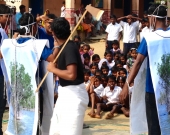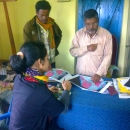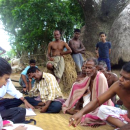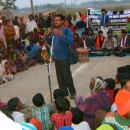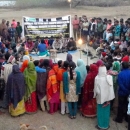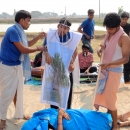Grants :: Small Grant Facilities :: Mangrove conservation and management: enhancing livelihood opportunities for mangrove dependent communities in Bhitarkanika reserve forest
Mangrove conservation and management: enhancing livelihood opportunities for mangrove dependent communities in Bhitarkanika reserve forest
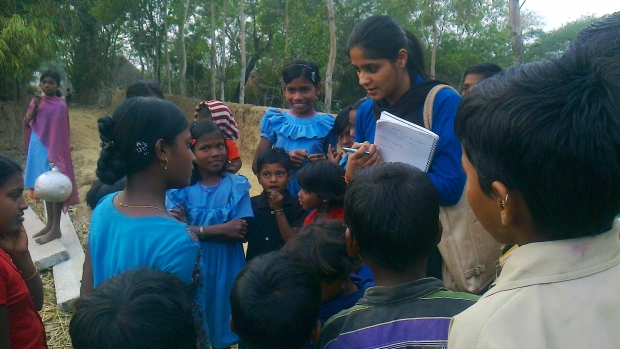
Socio-economic impacts and livelihoods hoods study, Kendrapara, Orissa, India © DA, 2012
Objectives
- Increasing awareness and capacities of local communities and community based institutions for the sustainable use of mangrove resources and reducing dependence of communities on mangrove resources by enhancing alternative livelihood opportunities. These interventions will also mainstream the potential and felt impacts of climate change impacts and ensure that alternative livelihoods and empowered institutions move towards climate change adaptation making communities and the mangroves they depend on more resilient in the face of climate change.
- Assessment and Monitoring of Mangrove Forest through land-use/ land cover mapping and change detection studies using Satellite Remote Sensing and GIS techniques for effective development and management of mangroves.
Background
In the past few decades, mangroves in India have been subject to a wide variety of threats. An estimate by the World Resources Institute (WRI) reveals that national proportions of mangrove loss vary between 4 to 84 percent. In many states, these threats can be attributed to anthropogenic pressures. The same is true of the Reserve forests in the Bhitarkanika wildlife sanctuary of Odisha. Here the threats include agriculture, shrimp farming, harvesting of fuel wood and timber, grazing by domestic animals, harvesting non-wood forest products, sewage discharge, and garbage disposal. Besides anthropogenic threats climate change looms in the background as a potential threat to the mangrove ecosystem, particularly sea level rise which is anticipated to accelerate in the coming decades.
More than two hundred and forty thousand inhabitants of nearly four hundred villages live within the sanctuary area. Almost eighty-one villages are located adjacent to the mangrove forests.
In the panchayats (village councils) of Bhitarkanika a traditional way of life prevails with a high reliance on natural resources for the livelihood and energy needs of communities. This dependence is detrimental to their economic development as well as harmful to the mangrove ecosystem and communities do not have the awareness or institutional support systems to move to alternative livelihoods, or regulate the use of resources from the mangrove ecosystem to ensure sustainability.
The overexploitation of mangrove resources and their destruction for alternate livelihood activities is unsustainable. Additionally, mangroves and the communities dependent on them are threatened by climate change. The current scenario, if left unchecked has the potential to lead to a loss of livelihoods, income and increased vulnerability of mangrove dependent communities.
Target beneficiaries
Communities of Chainrakolha and Garta villages, Kendrapara district, Orissa
Outputs
The expected outputs of this project are:
- Awareness generated and capacities built through workshops in 500 households in 2 villages of the Bhitarkanika reserve forest
- The development of a compendium of livelihood options (minimum 6) that reduce dependence on the mangrove ecosystem and lead communities towards climate change adaptation. As least 2 of these options will be demonstrated to the communities
- Land-use/land-cover change maps will be developed to highlight change in the mangrove cover and other land-cover categories for the development and management of mangroves in the region.
Accomplishments and challenges
A comprehensive baseline assessment was developed for both villages, Chainrakolha and Garta, through the Participatory Rural Assessment (PRA) and stakeholder consultations.98.31% of the households in both villages can be classified as Other Backward Classes (OBC) based on social, educational and economic factors (categorized by the Central Government of India). 15.25% of the families are completely landless, and approximately 47.46% have less than an acre of land to their name. An astounding 91.53% live in temporary houses. Agriculture, fishing and pisciculture are the predominant livelihoods practiced in both villages, with a large number of individuals (largely men) migrating out of the region in search of manual labor. On average families earn INR 39,000 annually, which is insufficient to cover their basic expenditure; over 50% are in debt. Although most of the community members are aware of the value of mangroves they are forced to depend on them heavily for their daily needs.
Development Alternatives (DA) and Bharat Integration Social Welfare Agency (BISWA) organized a three-day mangrove awareness drive, in and around Rangani Gram Panchayat of Rajnagar Block (in Patta Paria, Dola Sahi, Chanrakolla and Rangani villages. The programme was targeted at nine high schools, fifteen primary schools and twenty-five women Self Help Groups, as well as village leaders and youth; this was spread across seven regions within a thirty-kilometer radius.
A multi-stakeholder workshop was held in Bhubaneswar, on 8 March 2013 with the aim of identifying sustainable livelihood opportunities for communities in the Bhitarkanika Wildlife Sanctuary. The workshop built upon existing models that have previously been successfully introduced in mangrove areas, initiatives taken up by the Government of Odisha, and the identification of suitable new, supplementary livelihoods that can be demonstrated to and undertaken by local communities.
Demonstrations of how to make puffed rice were organized by DA and undertaken by Unnayan for the communities of Chainrakolha and Garta in mid-March 2013; 10 village leaders and members representing both communities attended. Demonstrations of integrated fish farming were organized by DA and undertaken by Gram Utthan, a local NGO, for the communities of Chainrakolha and Garta in mid-March 2013; 9 village leaders and members representing both communities attended.
Contributions to cross-cutting themes
Awareness and capacities of local communities and community-based institutions were increased for the sustainable use of mangrove resources and reduced dependence of communities on mangrove resources through the provision of supplementary livelihood opportunities. These interventions will also mainstream the potential and felt impacts of climate change impacts and ensure that supplementary livelihoods and empowered institutions move towards climate change adaptation making communities and the mangroves they depend on more resilient in the face of climate change
Lessons Learned
Piloting and integrating the livelihoods into the schemes/ programmes of the state: Programmes and schemes like TRIPTI, NRLM, ICZMP and livelihoods like integrated fish farming, puffed rice, box honey; fish processing (fish pickle and papad making) should be integrated to encourage future sustainability of livelihoods and ensure income security.
A greater number of awareness and capacity building programmes need to be designed, with the view of facilitating stakeholder interaction: It was noticed through the awareness programmes that communities were already conscious of the value of mangroves and the importance the ecosystems serves in their lives. What was apparent however, was that the communities often felt that they lacked the option to not depend on the mangroves for their daily lives and were unaware of how and whom to approach to change this. Through the awareness programmes and capacity development workshops the communities were introduced to new supplementary livelihoods and organizations that could help them in adopting these. A greater number of these programmes need to be designed, particularly for those villages and communities that are remotely located and often inaccessible.
Use of technology: Regular monitoring of land use and land cover changes needs to be undertaken and the output explained to communities, in order that the mangrove forests can be better managed.
Related News
Nukkad Natak (street theatre) and the mangroves of Kendrapara
Kendrapara, Orissa, India 13 Mar 2013
Country: India
Topic: Knowledge for Management, Capacity development, Civil Society Engagement ...
The new wave of environmental challenges (such as cross-boundary water disputes, climate change, etc.) is not often easily addressed within the social, economic and cultural frameworks of coastal communities in India. One of the primary reasons for t...
Featured Film - Spreading Awareness of Mangroves through Street Theater
Spreading Awareness of Mangroves through Street Theater , Rangani Gram Panchayat of Rajnagar Block (in Patta Paria, Dola Sahi, Chanrakolla and Rangani villages), Orissa © SANJOG/DA/MFF India, 2013
Street theater as a form of communication is deeply rooted in Indian tradition. The art form has been used to propagate various social messages and create awareness amongst local communities of critical issues that affect their lives and livelihoods. A primary component of the MFF India Small Grant Project related awareness campaign was nukkad natak (street theatre), performed by SANJOG (a cultural organization based in Bhubaneswar). The purpose of this drive was to inform the communities of the value of the Bhitarkanika mangroves to their lives and livelihoods and the threats that face them. Development Alternatives (DA) and Bharat Integration Social Welfare Agency (BISWA) organized a three-day mangrove awareness drive, in and around Rangani Gram Panchayat of Rajnagar Block (in Patta Paria, Dola Sahi, Chanrakolla and Rangani villages. The programme was targeted at nine high schools, fifteen primary schools and twenty-five women Self Help Groups, as well as village leaders and youth; this was spread across seven regions within a thirty-kilometer radius.
Project Facts
Country
Location
Chainrakolha and Garta village in the Ragani Panchayat of Rajnagar block, in the Bhitarkanika Wildlife Sanctuary, Orissa
Topic
- Knowledge for Management
- Strategies for Management
- Capacity Building
- Civil Society Engagement
- Community Resilence
- Gender equality
- Capacity development
- Knowledge management and communications
Duration
15th May 2012 to 15th Mar 2013
MFF Grant Amount
MFF Grant: INR 875,000
Co-financing Partner
DA: INR 90,000
Implementing Partner
Mr. Anand Kumar
Senior Programme Manager
Development Alternatives
akumar3@devalt.org
"I commit from the Rangani Panchyat people that we will take all steps to utilize the government funds and other means to preserve and conserve the mangrove ecosystem and undertake alternative livelihoods for our income" - Sarapanch, Rangani Gram Panchayat
Related Images
Related Publications
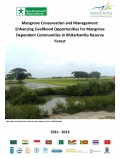
Mangrove Conservation and Management: Enhancing Livelihood Opportunities for Mangrove Dependent Communities in Bhitarkanika Reserve Forest
Author: Development Alternatives/MFF India
Publisher: Development Alternatives (DA)
Posted on: 21st Jun 2013
Category:
Size: 1.3 MB
